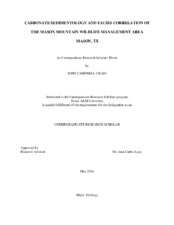| dc.creator | Craig, John Campbell | |
| dc.date.accessioned | 2017-10-10T20:11:36Z | |
| dc.date.available | 2017-10-10T20:11:36Z | |
| dc.date.created | 2017-05 | |
| dc.date.issued | 2015-09-28 | |
| dc.date.submitted | May 2017 | |
| dc.identifier.uri | https://hdl.handle.net/1969.1/164399 | |
| dc.description.abstract | A rise in the Cretaceous sea level roughly 140 million years ago resulted in the formation of the Edwards group of carbonate rocks amongst the exposed Precambrian aged igneous rocks of the Llano uplift in Central Texas. Within this region is The Mason Mountain Wildlife Management Area which currently serves as an exotic game ranch for the Texas Parks and Wildlife Department located North of Mason, TX. The geologic setting of the area is unique in that its origin contributes to a variety of different rocks that can be observed within the surrounding location. However, our focus will be centered upon a series of lower Cretaceous carbonate rocks comprising a group of lithostratigraphic units that can be identified as parts of the Fort Terret formation.
The objective of this study is to record the sedimentology of outcrop stations to identify and correlate facies of the Fort Terret formation. Traditional field methods were used to collect and record observations which were depicted as a series of measured sections for each station. This allowed us to break the Mason succession down into five main facies: Town Mountain granite, Hensel Sandstone, mudstone, bioclastic mudstone/wackestone, and rudist floatstone. A stratigraphic correlation of the succession was later rendered for a visual representation of the facies with respect to each station.
Ultimately, we will be able to explore the formation processes and depositional environments of the carbonate rocks in order to enhance our understanding of the succession within the management area. The facies descriptions supported by their correlations provided enough data for interpretations to be made about the succession leading up until its modern topography. The study concluded that the succession was formed under the general trend of eustatic sea level rise depositing new facies units in coastal environments with each stratigraphic system tract. | en |
| dc.format.mimetype | application/pdf | |
| dc.subject | Carbonate, Sedimentology, Stratigraphy | en |
| dc.title | Carbonate Sedimentology and Facies Correlation of the Mason Mountain Wildlife Management Area: Mason, TX | en |
| dc.type | Thesis | en |
| thesis.degree.discipline | Geology | en |
| thesis.degree.grantor | Undergraduate Research Scholars Program | en |
| dc.contributor.committeeMember | Laya, Juan Carlos | |
| dc.type.material | text | en |
| dc.date.updated | 2017-10-10T20:11:36Z | |


